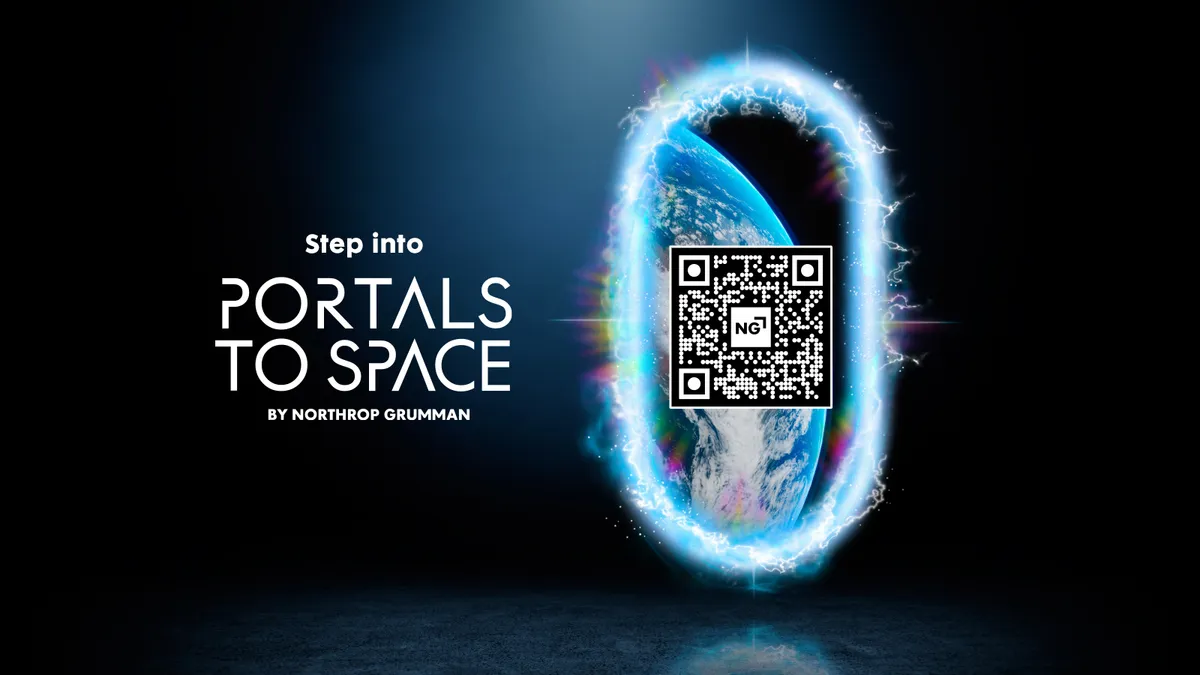Billionaires Richard Branson and Jeff Bezos in July made history with their trips to outer space, offering a glimpse of how the fledgling space tourism industry is advancing. More recently, aerospace and defense giant Northrop Grumman offered a glimpse of other space missions with an augmented reality (AR) experience for people on the ground.
Northrop Grumman's Portals to Space microsite shows mobile users an immersive view of how dying satellites can be repaired and refueled while still orbiting Earth. The AR activation comes as more people familiarize themselves with immersive technology like AR and virtual reality (VR). The number of people worldwide who use mobile AR is forecast to grow 33% to 800 million this year and reach 1.73 billion by 2024, per Statista data. As more consumers adopt higher-bandwidth mobile technologies like 5G, delivering data-intensive AR experiences at rapid speeds is expected to become more feasible.
The rollout of the AR experience coincided with the 36th Space Symposium, a yearly conference that brings together commercial, government and military participants. In addition to showcasing its wares among space industry insiders who attended the event, Northrop Grumman also sought to reach its customer community, space enthusiasts, current and future employees and the general public.
"We want viewers to recognize that Northrop Grumman is doing important things in space that are influencing the future of the industry," said Sean Wilson, director of media and public relations at Northrop Grumman Space Systems. "We have a very passionate workforce who is dedicated to bringing new technologies to bear for our customers."
Space-based services are in greater demand with government agencies and private companies launching thousands of satellites in the past few years for communications, navigation and other missions, The Wall Street Journal reported. Northrup Grumman and Lockheed Martin this month participated in a more than $10 million financing round for Orbit Fab, a startup that aims to launch two satellite refueling shuttles by as early as next year.
Virtual journey into space
Visiting the Portals to Space site with a mobile device opens a virtual window to a location 22,000 miles above Earth. Moving a smartphone or tablet in different directions shows the sun, moon and Milky Way in the distance while satellites flicker nearby. A narrator explains the satellite rescue mission as an animated spacecraft comes into view. It launches the Mission Robotic Vehicle (MRV), which extends its antennas, solar panels and guidance system as it flies by at 17,000 miles per hour. The voiceover also explains how Mission Extension Pods (MEPs) work to extend the operating life of customer satellites.
"The MRV Portal to Space is the first time our team has brought to life a WebAR Portal with this enhanced level of detail and storytelling."

Dave Meeker
Head of design and innovation practice, Dentsu Americas
In addition to the launch of the experience at the Space Symposium, Northrop Grumman's marketing for the activation includes custom paid partnerships with Wired, The Washington Post and Defense One. Northrop Grumman worked with Dentsu creative agencies DentsuMB and Isobar, along with customer experience management agency Merkle to develop the AR experience.
"Portals to Space is a way to give audiences a chance to not only see, but to actually experience, the next generation of solutions in space,” said Craig Cimmino, executive creative director at DentsuMB. "By using AR, we're telling Northrop Grumman's story in a tech-forward way by allowing viewers to "step in" to space, emphasizing the importance and difficulty of the mission, while giving users a sense of awe and wonder."
He said the goal was to provide compelling visuals in the AR experience to better demonstrate Northrop Grumman's technologies to those who may not understand its latest innovations. In developing the AR experience, Dentsu relied on software tools including Unreal Engine and 8th Wall, using some of the same methodologies as for other agency clients.
"The MRV Portal to Space is the first time our team has brought to life a WebAR Portal with this enhanced level of detail and storytelling," said Dave Meeker, head of design and innovation practice at Dentsu Americas. "This work also reflects an evolved version of narrative techniques like spatial audio that we've experimented with on projects with similar briefs. For Northrop Grumman, we are using what we have built in the past as a foundation to start from as we venture into unknown spaces."












